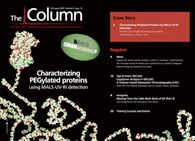Charting the microbial landscape
Research has used chromatography to provide a glimpse into the metalloprotein world, revealing the metals? extent and the promise of new insights for cell biology, microbial growth and toxicity mechanisms.
Metals in proteins provide virtually unlimited catalytic potential, enable electron transfer reactions and have a great impact on protein stability. This means metalloproteins play a key role in many biological processes including respiration (iron and copper), photosynthesis (manganese) and drug metabolism (iron). However, predicting what metals will be present in an organism from the genome is currently impossible because metal coordination sites are diverse and poorly recognized. Research published in the journal Nature1 has used chromatography to provide a glimpse into the metalloproteins world, revealing the metals’ extent and the promise of new insights for cell biology, microbial growth and toxicity mechanisms.
According to the team the new approach shifts the focus from classical protein-based purification to metal-based identification and purification by liquid chromatography, high-throughput tandem mass spectrometry and inductively coupled plasma mass spectrometry. They catalogued the metals in three microbes: one that lives in human intestines, one from a hotspring in Yellowstone National Park and one that thrives in the near boiling waters of undersea thermal vents. The research uncovered a microbial world far richer in metals than ever expected. “We thought we knew most of the metalloproteins out there,” says John Tainer of Berkeley Lab’s Life Sciences Division and the Scripps Research Institute in La Jolla, California, USA. “But it turns out we only know a tiny fraction of them. We now have to look at microbial genomes with a fresh eye.”
1. A. Cvetkovic et al., Nature, 466, 779-782 (2010).
This story originally appeared in The Column. Click here to view that issue.

Determining Enhanced Sensitivity to Odors due to Anxiety-Associated Chemosignals with GC
May 8th 2025Based on their hypothesis that smelling anxiety chemosignals can, like visual anxiety induction, lead to an increase in odor sensitivity, a joint study between the University of Erlangen-Nuremberg (Erlangen, Germany) and the Fraunhofer Institute for Process Engineering and Packaging (Freising, Germany) combined behavioral experiments, odor profile analysis by a trained panel, and instrumental analysis of odorants (gas chromatography-olfactometry) and volatiles (gas chromatography-mass spectrometry).
Investigating 3D-Printable Stationary Phases in Liquid Chromatography
May 7th 20253D printing technology has potential in chromatography, but a major challenge is developing materials with both high porosity and robust mechanical properties. Recently, scientists compared the separation performances of eight different 3D printable stationary phases.
Detecting Hyper-Fast Chromatographic Peaks Using Ion Mobility Spectrometry
May 6th 2025Ion mobility spectrometers can detect trace compounds quickly, though they can face various issues with detecting certain peaks. University of Hannover scientists created a new system for resolving hyper-fast gas chromatography (GC) peaks.

.png&w=3840&q=75)

.png&w=3840&q=75)



.png&w=3840&q=75)



.png&w=3840&q=75)









